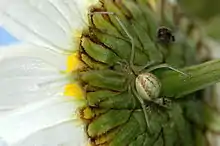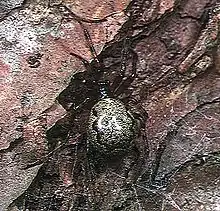Enoplognatha
Enoplognatha is a genus of comb-footed spiders that was first described by P. Pavesi in 1880.[3] They have both a large colulus and a subspherical abdomen. Males usually have enlarged chelicerae. It is considered a senior synonym of Symopagia.[2]
| Enoplognatha | |
|---|---|
 | |
| female E. ovata | |
 | |
| female E. abrupta | |
| Scientific classification | |
| Kingdom: | Animalia |
| Phylum: | Arthropoda |
| Subphylum: | Chelicerata |
| Class: | Arachnida |
| Order: | Araneae |
| Infraorder: | Araneomorphae |
| Family: | Theridiidae |
| Genus: | Enoplognatha Pavesi, 1880[1] |
| Type species | |
| E. mandibularis (Lucas, 1846) | |
| Species | |
|
74, see text | |
| Synonyms[1] | |
Among the theridiids, they are medium to large sized. E. maricopa, a red-brown spider with a mottled purplish abdomen, has males that reach a length of 3.4 millimetres (0.13 in), and females that reach 2.9 millimetres (0.11 in). E. peruviana females can grow to 6.5 millimetres (0.26 in) long, and female E. zapfeae can grow to 9.2 millimetres (0.36 in).[4]
Species
As of September 2019 it contains seventy-four species with a cosmopolitan distribution, including Greenland and Western Australia:[1]
- E. abrupta (Karsch, 1879) – Russia (Far East), China, Korea, Japan
- E. afrodite Hippa & Oksala, 1983 – Southern Europe
- E. almeriensis Bosmans & Van Keer, 1999 – Portugal, Spain
- E. angkora Barrion, Barrion-Dupo & Heong, 2013 – China
- E. apaya Barrion & Litsinger, 1995 – Philippines
- E. bidens Simon, 1908 – Australia (Western Australia)
- E. biskrensis Denis, 1945 – Morocco, Algeria, Tunisia
- E. bobaiensis Zhu, 1998 – China
- E. bryjai Řezáč, 2016 – Czechia
- E. cariasoi Barrion & Litsinger, 1995 – Philippines
- E. caricis (Fickert, 1876) – Europe, Turkey, Russia (Europe to Far East), China, Korea, Japan
- E. carinata Bosmans & Van Keer, 1999 – Morocco, Algeria
- E. daweiensis Yin & Yan, 2012 – China
- E. deserta Levy & Amitai, 1981 – Morocco to Israel, Russia (Europe)
- E. diodonta Zhu & Zhang, 1992 – Pakistan, India, China
- E. diversa (Blackwall, 1859) – Canary Is., Madeira, Portugal, Spain, France, Morocco to Greece
- E. franzi Wunderlich, 1995 – Mediterranean, Iraq
- E. fuyangensis Barrion & He, 2017 – China
- E. gemina Bosmans & Van Keer, 1999 – Mediterranean to Azerbaijan
- E. gershomi Bosmans & Van Keer, 1999 – Israel
- E. giladensis (Levy & Amitai, 1982) – Greece (Rhodes), Turkey, Israel, Azerbaijan
- E. goulouensis Yin & Yan, 2012 – China
- E. gramineusa Zhu, 1998 – China
- E. hermani Bosmans & Van Keer, 1999 – Algeria
- E. inornata O. Pickard-Cambridge, 1904 – South Africa
- E. intrepida (Sørensen, 1898) – USA, Canada, Greenland, Korea
- E. iraqi Najim, Al-Hadlak & Seyyar, 2015 – Iraq, Iran
- E. joshua Chamberlin & Ivie, 1942 – USA
- E. juninensis (Keyserling, 1884) – Peru
- E. kalaykayina Barrion & Litsinger, 1995 – Philippines
- E. latimana Hippa & Oksala, 1982 – Canada, Europe, North Africa, Turkey, Caucasus, Russia (Europe) to Central Asia, Iran
- E. lordosa Zhu & Song, 1992 – China, Japan
- E. macrochelis Levy & Amitai, 1981 – North Macedonia, Greece, Turkey, Cyprus, Israel, Azerbaijan, Iran
- E. malapahabanda Barrion & Litsinger, 1995 – Philippines
- E. mandibularis (Lucas, 1846) (type) – Europe, North Africa, Turkey, Israel, Russia (Europe) to Central Asia, Iran, China
- E. mangshan Yin, 2012 – China
- E. margarita Yaginuma, 1964 – Kazakhstan, Russia (Central Asia to Far East), China, Korea, Japan
- E. mariae Bosmans & Van Keer, 1999 – Greece, Russia (Caucasus)
- E. maricopa Levi, 1962 – USA
- E. marmorata (Hentz, 1850) – North America
- E. maysanga Barrion & Litsinger, 1995 – Philippines
- E. mediterranea Levy & Amitai, 1981 – Turkey, Cyprus, Israel, Azerbaijan, Iran
- E. melanicruciata Saito, 1939 – Japan
- E. molesta O. Pickard-Cambridge, 1904 – South Africa
- E. monstrabilis Marusik & Logunov, 2002 – Russia (South Siberia)
- E. mordax (Thorell, 1875) – Europe, North Africa, Turkey, Caucasus, Russia (Europe) to Tajikistan, Iran, China
- E. nigromarginata (Lucas, 1846) – Spain to Greece, Morocco, Algeria
- E. oelandica (Thorell, 1875) – Europe, Caucasus, Kazakhstan, China
- E. oreophila (Simon, 1894) – Sri Lanka
- E. orientalis Schenkel, 1963 – China
- E. ovata (Clerck, 1757) – North America, Europe, Turkey, Caucasus, Russia (Europe to Middle Siberia), Kazakhstan, Iran, Central Asia, Japan
- E. parathoracica Levy & Amitai, 1981 – Turkey, Israel, Azerbaijan
- E. penelope Hippa & Oksala, 1982 – Bulgaria, Greece (incl. Crete)
- E. peruviana Chamberlin, 1916 – Peru
- E. philippinensis Barrion & Litsinger, 1995 – Philippines
- E. procerula Simon, 1909 – South Africa
- E. pulatuberculata Barrion & Litsinger, 1995 – Philippines
- E. puno Levi, 1962 – Peru
- E. qiuae Zhu, 1998 – China
- E. quadripunctata Simon, 1884 – Mediterranean, Caucasus, Kazakhstan
- E. robusta Thorell, 1898 – Myanmar
- E. sattleri Bösenberg, 1895 – Madeira, Salvages, Canary Is.
- E. selma Chamberlin & Ivie, 1946 – USA
- E. serratosignata (L. Koch, 1879) – Europe, Caucasus, Russia (Europe to Far East), Kazakhstan, China
- E. tadzhica Sytshevskaja, 1975 – Tajikistan
- E. testacea Simon, 1884 – Southern, Central Europe to Central Asia
- E. thoracica (Hahn, 1833) – North America, Europe, Turkey, North Africa, Syria, Iran, Turkmenistan
- E. turkestanica Charitonov, 1946 – Iran, Central Asia
- E. tuybaana Barrion & Litsinger, 1995 – Philippines
- E. verae Bosmans & Van Keer, 1999 – Morocco, Spain, Tunisia, Italy, Greece
- E. wyuta Chamberlin & Ivie, 1942 – USA
- E. yelpantrapensis Barrion & Litsinger, 1995 – Philippines
- E. yizhangensis Yin, 2012 – China
- E. zapfeae Levi, 1962 – Chile
In synonymy:
- E. aituarca Esyunin & Efimik, 1998 = Enoplognatha serratosignata (L. Koch, 1879)
- E. albimaculosa (Saito, 1934, T from Steatoda) = Enoplognatha caricis (Fickert, 1876)
- E. ambigua Kulczyński, 1894 = Enoplognatha serratosignata (L. Koch, 1879)
- E. arganoi (Brignoli, 1980, T from Robertus) = Enoplognatha testacea Simon, 1884
- E. camtschadalica Kulczyński, 1885 = Enoplognatha caricis (Fickert, 1876)
- E. corollata (Bertkau, 1883) = Enoplognatha oelandica (Thorell, 1875)
- E. cottarellii (Brignoli, 1980) = Enoplognatha testacea Simon, 1884
- E. crucifera (Thorell, 1875) = Enoplognatha mordax (Thorell, 1875)
- E. dorsinotata Bösenberg & Strand, 1906 = Enoplognatha caricis (Fickert, 1876)
- E. elimata (L. Koch, 1882, T from Theridion) = Enoplognatha diversa (Blackwall, 1859)
- E. hangzhouensis Zhu, 1998 = Enoplognatha abrupta (Karsch, 1879)
- E. hungarica Kolosváry, 1934 = Enoplognatha serratosignata (L. Koch, 1879)
- E. jacksoni Schenkel, 1927 = Enoplognatha serratosignata (L. Koch, 1879)
- E. japonica Bösenberg & Strand, 1906 = Enoplognatha caricis (Fickert, 1876)
- E. joshua Chamberlin & Ivie, 1942 = Enoplognatha joshua Chamberlin & Ivie, 1942
- E. krasnojarskensis (Strand, 1903, removed from S of Theridion undulatum) = Enoplognatha serratosignata (L. Koch, 1879)
- E. mansueta (L. Koch, 1882, T from Theridion) = Enoplognatha mandibularis (Lucas, 1846)
- E. maritima Simon, 1884 = Enoplognatha mordax (Thorell, 1875)
- E. marmorata Chamberlin & Ivie, 1942 = Enoplognatha marmorata (Hentz, 1850)
- E. militaris Wunderlich, 1995 = Enoplognatha latimana Hippa & Oksala, 1982
- E. mimoides (Chamberlin, 1920) = Enoplognatha marmorata (Hentz, 1850)
- E. nigrocincta Simon, 1884 = Enoplognatha mandibularis (Lucas, 1846)
- E. pikes Chamberlin & Ivie, 1942 = Enoplognatha intrepida (Sørensen, 1898)
- E. piuta Chamberlin & Ivie, 1942 = Enoplognatha joshua Chamberlin & Ivie, 1942
- E. puritana Chamberlin & Ivie, 1942 = Enoplognatha caricis (Fickert, 1876)
- E. redimita (Linnaeus, 1758, T from Theridion) = Enoplognatha ovata (Clerck, 1757)
- E. robustula Roewer, 1942 = Enoplognatha diversa (Blackwall, 1859)
- E. rugosa Emerton, 1908 = Enoplognatha intrepida (Sørensen, 1898)
- E. schaufussi (L. Koch, 1882) = Enoplognatha mordax (Thorell, 1875)
- E. submargarita Yaginuma & Zhu, 1992 = Enoplognatha margarita Yaginuma, 1964
- E. tecta Keyserling, 1884 = Enoplognatha caricis (Fickert, 1876)
- E. thoracicoides Nosek, 1905 = Enoplognatha quadripunctata Simon, 1884
- E. transversifoveata (Bösenberg & Strand, 1906) = Enoplognatha abrupta (Karsch, 1879)
See also
References
- "Gen. Enoplognatha Pavesi, 1880". World Spider Catalog Version 20.0. Natural History Museum Bern. 2019. doi:10.24436/2. Retrieved 2019-10-27.
- Levi, H. W.; Levi, L. R. (1962). "The genera of the spider family Theridiidae". Bulletin of the Museum of Comparative Zoology. 127: 27.
- Pavesi, P. (1880). "Studi sugli Aracnidi africani. I. Aracnidi di Tunisia". Annali del Museo Civico di Storia Naturale di Genova. 15: 283–388.
- Levi, H.W. (1962). "The Spider Genera Steatoda and Enoplognatha in America (Araneae, Theridiidae)". Psyche. 69: 11–36.
External links
| Wikimedia Commons has media related to Enoplognatha. |